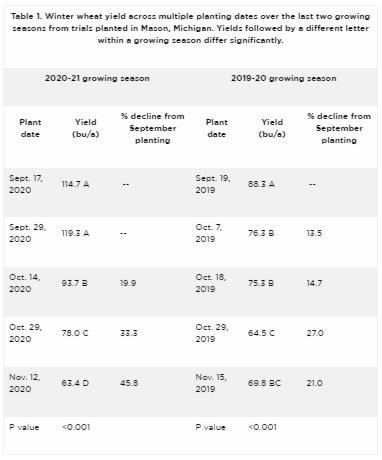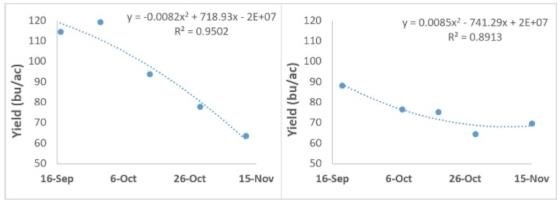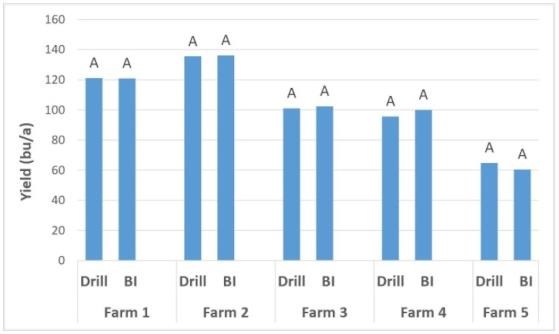In a perfect world, wheat should be planted soon after the Hessian fly-free date. Highest yields are often attained when seedlings emerge within two weeks following the posted fly-free date, assuming heat unit accumulation is near average in October and November. The goal is to plant early enough to produce two to three tillers before the winter vernalization period.
That being said, planting early isn’t always possible. Frequent heavy rains this fall have delayed soybean harvest and wheat planting. According to the USDA Michigan Crop Weather Report from Oct. 25, 2021, soybean harvest is at 49% complete, down from 72% last year and wheat planted is at 68%, down from 90% last year. Listed below are some management strategies to keep in mind while deadling with late planting of wheat.
Planting date
Planting date studies show losses in yield potential for late planted wheat but it is variable from year to year. Data from a planting date study funded by the Michigan Wheat Program conducted at the Michigan State University Mason Research Farm in 2019-20 and 2020-21 is presented in Table 1. Wheat was planted one five dates starting in mid-September and continuing about every two weeks until mid-November. The 2020-21 wheat crop had higher yield potential compared to the 2019-20 wheat crop. In these trials, planting in end-October or later resulted in 33-46% yield decline (2020-21 crop) and 21-27% yield decline (2019-20 crop) compared to September planting.

Figure 1 shows the same data in a graphical format. As you get later in the year, the yields declined but you can see the difference in the trends between the two years much more clearly.

Figure 1. Winter wheat yield across multiple planting dates in the 2020-21 growing season (left panel) and 2019-20 growing season (right panel).
Seeding rate and depth
The recommended seeding rate for wheat is to plant between 1.2 and 2 million seeds per acre. If you are planting within a week of the hessian fly-free date, use seeding rates on the lower end of the range to avoid overly thick stands that can promote disease development and increase the likelihood of lodging the following season.
As the calendar advances, seeding rates should become progressively higher. If planting continues into the third week of October, increase your seeding rates to 1.8 or 2.0 million seeds per acre or more (26 or more seeds per foot of row). Also, planting shallower (around 1 inch or less) will allow the seedlings to emerge more quickly and start tillering. If planting in early November, these seedlings may not emerge until next spring.
Planting method
There has recently been increased interest in broadcast incorporation (BI) of wheat seed. An air seeder mounted on a high speed tillage tool has been the preferred method. This allows for faster planting and more acres planted per day. A study funded by the Michigan Wheat Program was initiated in 2020-21 crop to evaluate broadcast incorporation against other planting methods. Data from year one of the study suggest that broadcast incorporation can produce yields comparable to drilled wheat (Figure 2), as all five locations had similar yield between the two planting methods. However, there are two important caveats with this data: 1) It is from only one growing season and 2) all five sites in this trial were planted early (before Oct. 10).
While broadcast incorporation could be a method to get the remaining acres of wheat planted this fall, remember that we do not have data on yield potential of late planted wheat using this method. Oct. 25 is the planting deadline for crop insurance, so the later it gets, the more risk the grower must assume.

Figure 2. Winter wheat yield in drilled versus broadcast incorporated (BI) planting methods at five Michigan farms during the 2020-21 growing season. Seeding rate was similar across planting methods and ranged from 1.2 to 1.7 million seeds per acre. Bars with a similar letter within a farm do not differ significantly at P<0.10.
Other considerations
As fall progresses, late-planted wheat seeds might be slower to emerge due to lower temperatures. In order to protect the vulnerable seed from soil-borne diseases, consider fungicide seed treatments.
If you plan to plant wheat in late October or even early November, make sure to apply approximately 20 pounds per acre of nitrogen fertilizer this fall, hoping that an extended fall season may allow some tiller development. To further promote tillering, apply some or all of next spring’s nitrogen early during green-up.
Wheat is responsive to phosphorus, so starter fertilizer should contain the appropriate amount of phosphorus in the starter based on soil test levels. Some have questioned if adding phosphorus fertilizer would be more important when planting late compared to early planting. MSU research shows that you do not get any added benefit from starter phosphorus when planting late.
Source : msu.edu